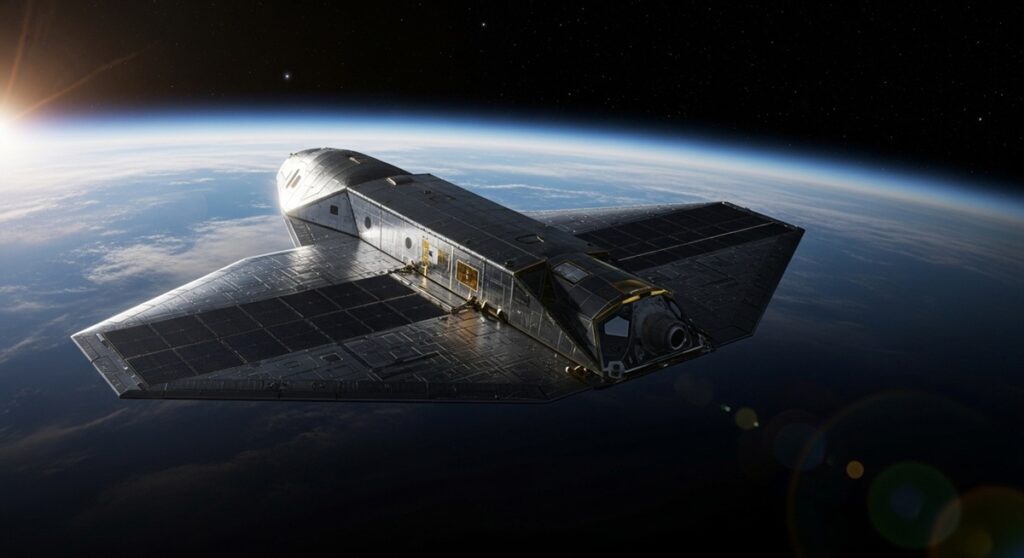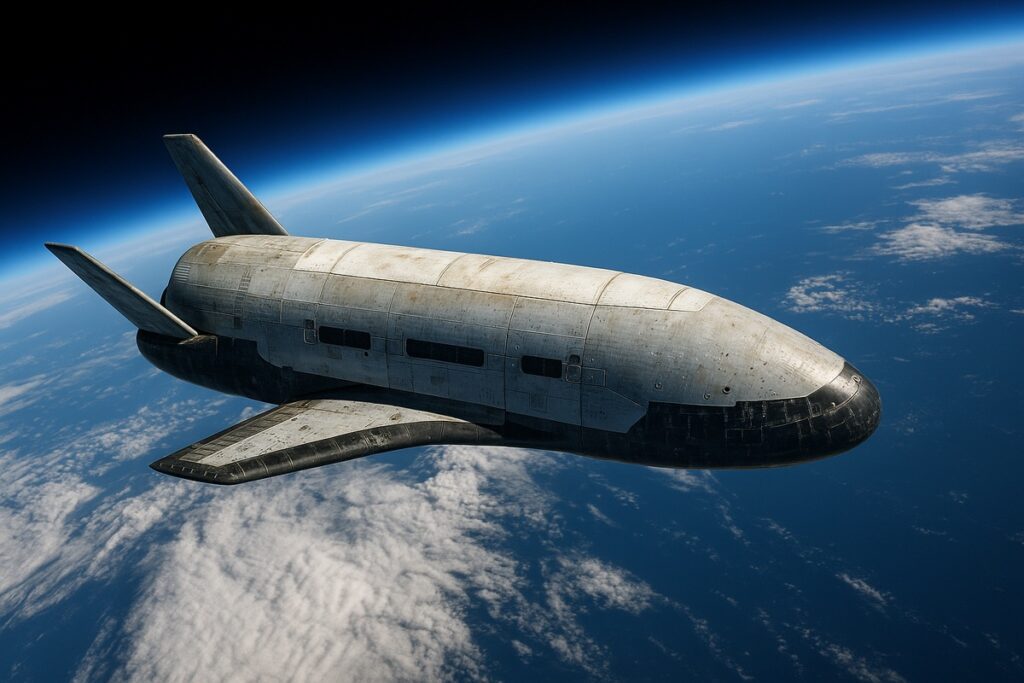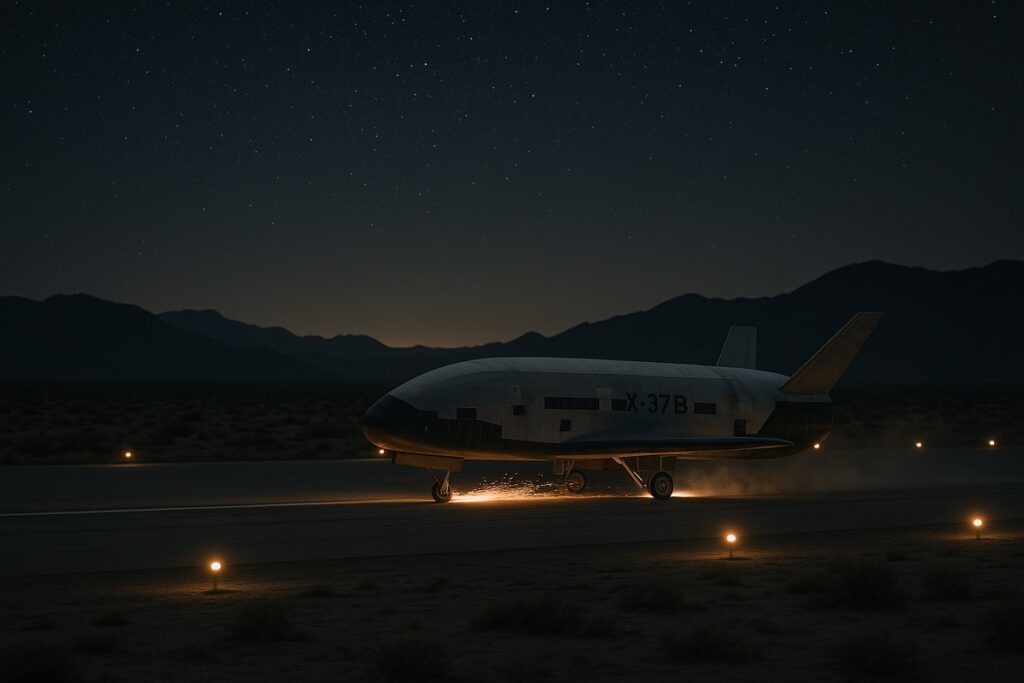Imagine a sleek, unmanned spaceplane slicing through the void of space, carrying experiments that could redefine how we navigate the stars—and perhaps even challenge our reliance on everyday tech like GPS. That’s the reality of the U.S. Space Force’s X-37B, a mysterious orbital test vehicle that’s been captivating space enthusiasts, military analysts, and conspiracy theorists alike for over a decade.
In late August 2025, this compact powerhouse blasted off on its eighth mission, shrouded in secrecy as always, but with whispers of groundbreaking quantum technology at its core. What if this isn’t just another routine flight? What if it’s a leap toward a future where satellites, submarines, and spacecraft can find their way without a single signal from Earth?
The X-37B’s latest adventure isn’t just about pushing boundaries—it’s about addressing real-world vulnerabilities in our navigation systems. From jammed signals in conflict zones to the dead zones of deep space, the quest for reliable alternatives to GPS has never been more urgent. And now, rumors suggest this mission is testing a quantum device that could make traditional satellite navigation obsolete. But amid the hype, scientists are debating: Is this a genuine breakthrough, or just another layer of military mystique?
The X-37B Spaceplane: A Brief History
The X-37B isn’t your typical spacecraft. Resembling a miniaturized version of NASA’s retired Space Shuttle, this Boeing-built marvel measures about 29 feet long—roughly the size of a small school bus—and weighs in at around 11,000 pounds. It’s fully autonomous, capable of launching atop a rocket, orbiting Earth for months or even years, and gliding back to a runway landing like an airplane. But unlike civilian missions that broadcast every detail, the X-37B operates under a veil of classification, courtesy of the U.S. Space Force and the Department of Defense.
From Concept to Reality
The roots of the X-37B trace back to the late 1990s, when NASA initiated the project as part of its efforts to develop reusable space vehicles. By 2004, the program shifted to the military, with the Air Force (and later the Space Force) taking the reins. The first orbital test vehicle, OTV-1, launched in 2010, spending 224 days in space before returning. Each subsequent mission has grown longer and more ambitious, with OTV-6 clocking an astonishing 908 days in orbit before landing in 2022.

What makes the X-37B stand out is its versatility. It’s essentially a flying laboratory, testing everything from advanced materials to solar power systems. But the military’s tight-lipped approach fuels endless speculation. Is it a spy platform? A weapon delivery system? Or something more benign, like a testbed for future deep-space tech? Official statements emphasize experimentation, but the lack of transparency leaves room for imagination.
Previous Missions and Achievements
Over seven missions, the X-37B has racked up impressive milestones. OTV-4, for instance, tested an experimental Hall-effect thruster for more efficient propulsion. OTV-5 carried seeds to study radiation’s effects on plant growth, hinting at applications for long-duration space travel. And OTV-7, which wrapped up in late 2024, focused on aerobraking maneuvers—using Earth’s atmosphere to adjust orbit without fuel, a technique that could extend mission lifespans dramatically.
These flights have also demonstrated the spaceplane’s reusability, with the same vehicles flying multiple times. Boeing has built two X-37Bs, and their durability has proven the concept of rapid turnaround for space operations. Yet, for all the public tidbits, much remains classified. As one Space Force official put it in a 2024 briefing, “We’re pushing the envelope on what’s possible in orbit—details forthcoming… or not.”
The Latest Mission: OTV-8 Takes Flight
Fast-forward to August 21, 2025, when SpaceX’s Falcon 9 rocket roared to life from Kennedy Space Center, lofting the X-37B into orbit for its eighth outing, dubbed OTV-8 or USSF-36. This launch marked a shift: Unlike previous missions that used Atlas V rockets, OTV-8 rode a Falcon 9, showcasing the growing partnership between the military and private space firms. The booster even landed successfully, adding to SpaceX’s tally of reusable hardware.

But the real intrigue lies in the payload. While details are sparse, official releases confirm experiments in laser communications and quantum navigation—technologies that could revolutionize military operations.
Launch Details and Payload
Liftoff occurred at around 9:14 p.m. EDT, with the X-37B separating smoothly and entering a low-Earth orbit. The mission’s duration? Classified, but past flights suggest it could last anywhere from months to years. Onboard are demonstrations from government partners, including a quantum inertial sensor developed by Vector Atomic and Honeywell Aerospace, in collaboration with the Defense Innovation Unit.
This sensor aims to provide ultra-precise positioning, navigation, and timing (PNT) in environments where GPS fails. Another highlight: Laser links for high-speed data transfer, potentially enabling secure communications immune to jamming. These are responses to real threats, like signal disruptions from adversaries.
As the Space Force announced, this flight represents “a notable benchmark in quantum sensing,” marking the first orbital test of such advanced tech.
Quantum Navigation: The Future of GPS Alternatives
At the heart of OTV-8 is the quantum experiment—a bid to create a GPS-independent navigation system. Traditional GPS relies on satellite signals, but those can be weak in space, nonexistent underwater, or easily spoofed on Earth. Enter quantum navigation, which promises accuracy without external references.
How It Works: Atom Interferometry Explained
Picture this: Atoms cooled to near absolute zero, behaving like waves rather than particles. That’s the magic of atom interferometry, the tech powering this quantum sensor. Lasers split these atomic waves into superposition states—think Schrödinger’s cat, alive and dead at once—then recombine them to measure tiny changes in motion.
The result? Detection of accelerations and rotations with mind-boggling precision, far surpassing mechanical gyroscopes. Errors that accumulate in conventional inertial systems (known as “drift”) are minimized, allowing for long-term navigation without corrections.

Analogies help here. If a regular INS is like navigating by feeling bumps in the road with your eyes closed, quantum navigation is like having an internal atomic clock and ruler that never wavers. Boeing tested a similar system in a 2025 flight, maintaining accuracy for hours without GPS.
Challenges in Space
Of course, it’s not all smooth sailing. Quantum sensors are finicky: They need vacuum conditions, ultra-low temperatures, and stable lasers. In space, vibrations, radiation, and thermal fluctuations pose hurdles. Experts like those at NASA, who tested related tech on the ISS, note that while lab results are promising, orbital reliability is unproven.
The X-37B’s compact design adds complexity—fitting this into a military vehicle isn’t easy. Yet, if successful, it could enable autonomous missions to the Moon or Mars, where Earth signals lag or vanish.
Expert Opinions and Global Race
Skeptics abound. “We’re talking lab-level tech thrust into space,” says one physicist in a recent analysis. “Results are interesting, but full GPS replacement? Decades away.” Still, the global push is on. China and the UK have tested quantum sensors in aircraft and subs, with a 2024 UK flight demo lasting hours without GPS.
The U.S. leads, but competition is fierce. As one X post quipped, “Quantum nav on X-37B? Game-changer for Space Force.” This mission could validate the hype, or highlight the gaps.
Military Implications and Beyond
Beyond navigation, quantum tech opens doors to secure comms and computing. For the military, it’s about independence—navigating jammed skies or hacked satellites. Imagine drones or subs operating undetected, or spacecraft dodging debris with pinpoint accuracy.
Civilian perks? Safer aviation, precise mapping, even better smartphones. But ethical questions loom: Does this escalate space militarization? With Russia and China eyeing similar tech, the race feels like a new Cold War frontier.
The Soviet Roots: Fact or Fiction?
Adding intrigue are claims that the X-37B isn’t purely American ingenuity. Some experts allege it draws from the Soviet Union’s Spiral program, a 1960s effort to build an orbital fighter plane.
The Spiral Program
Initiated in 1965, Spiral envisioned a reusable spaceplane for reconnaissance and strikes, with a lifting-body design for atmospheric reentry. Canceled in the 1970s due to costs and politics, its blueprints reportedly influenced U.S. projects like the HL-20 and Dream Chaser.
Former Soviet engineers point to similarities: The X-37B’s shape, landing gear, and concept echo Spiral’s. “It’s the heir to our school,” one claimed in a 2020 interview.
Alleged Technology Transfer
How did this happen? Rumors swirl of stolen tech during the Cold War’s end, when Soviet designs leaked amid economic chaos. U.S. officials deny it, crediting independent evolution from NASA studies. But among insiders, the conviction persists: The X-37B’s DNA is partly Russian.

This narrative adds a spy-thriller twist, reminding us that space innovation often builds on global legacies—willingly or not.
Breakthrough or Buzz?
As the X-37B orbits silently, we’re left pondering: Will quantum navigation deliver a “leap” forward, or remain hype? The military’s secrecy means we might never know the full story, but glimpses suggest a transformative era. From Mars missions to everyday tech, the ripple effects could be profound.
In the end, the X-37B embodies humanity’s drive to conquer the unknown—pushing limits, one classified experiment at a time.

















